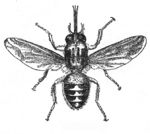Difference between revisions of "Glossinidae"
| Line 48: | Line 48: | ||
The complete life cycle of the ''Glossina'' is 2 months. | The complete life cycle of the ''Glossina'' is 2 months. | ||
| − | |||
| − | |||
| − | |||
| − | |||
| − | |||
| − | |||
| − | |||
| − | |||
| − | |||
| − | |||
| − | |||
| − | |||
| − | |||
| − | |||
| − | |||
| − | |||
| − | |||
| − | |||
| − | |||
| − | |||
| − | |||
[[Category:Biting_Flies]] | [[Category:Biting_Flies]] | ||
[[Category:To_Do_-_Max]] | [[Category:To_Do_-_Max]] | ||
[[Category:To_Do_-_Review]] | [[Category:To_Do_-_Review]] | ||
Revision as of 12:17, 26 July 2010
| Also known as: | TseTse flies |
The only genus in the family Glossinidae is Glossina, more commonly known as TseTse flies. They are solely found in sub-Sahara Africa, and feed on the blood of vertebrates.
Scientific Classification
| Kingdom | Animalia |
| Phylum | Arthropoda |
| Class | Insecta |
| Order | Diptera |
| Superfamily | Hippoboscoidea |
| Family | Glossinidae |
| Genus | Glossina |
Hosts
Various mammals, reptiles and birds.
Identification
TseTse flies are 6-13mm in length, and have long, prominent forward pointing proboscis. They have a green thorax, and a yellow/brown abdomen. The wings are a very characteristic 'butchers cleaver' shape.
The larvae are a creamy white colour, and clearly segmented.
Life cycle
The females are viviparous, and only lay a single egg at a time. The fertilized eggs are held in the oviduct, where they hatch into larvae. The larvae develop, and when they are fully mature the larvae drop onto the ground.
The larvae then form pupae. This process takes several weeks, but can be considerably longer under cool conditions. The pupae transform into adults around one month later. The TseTse flies are blood feeders, and the females will require several good blood meals, before producing their first larva.
The complete life cycle of the Glossina is 2 months.
